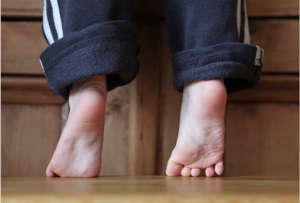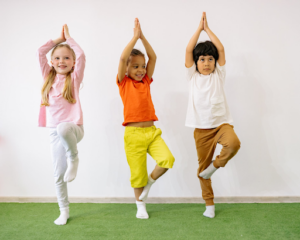
What does it mean to “cross midline,” and why is it important?
The ability to cross midline involves moving a body part across the center of the body (midline) to the opposite side in a smooth or fluid manner. This movement is essential for learning to use both sides of the body together. This skill is closely associated with brain development, as the two sides, or hemispheres, of the brain must communicate to coordinate learning and movement. Crossing midline promotes a child’s ability to reach for and explore new toys or objects, learn to creep and crawl, develop patterns for self-feeding, and interact more fully with the environment as infants and toddlers. As children continue to grow, crossing midline becomes an important skill needed for the development of fine and visual motor coordination.
If a child is unable to cross midline, they may tend to use their left hand to complete activities on the left side of the body and their right hand to complete activities on the right side of the body, impeding their ability to develop a preferred or dominant hand. Hand dominance impacts a child’s ability to use tools effectively, including pencils, markers, and scissors, so difficulty crossing midline often affects handwriting, cutting, and other school-related fine motor tasks. A child’s ability to smoothly cross midline with their eyes, arms, and legs also plays a significant role in developing reading skills, eye-hand coordination, gross motor skills, and independence with self-care tasks and impacts overall quality of movement within age-appropriate activities and routines.
Difficulties with crossing midline may be present if your child:
- Uses their left hand to complete tasks on the left side of the body and their right hand to complete tasks on the right side of the body
- Switches writing utensils between hands to avoid crossing midline during writing, drawing, or coloring activities
- Demonstrates difficulty coordinating smooth gross motor movements that involve both sides of the body (for example, skipping, catching/throwing/kicking a ball)
- Rotates their trunk to retrieve objects during play or seated activities instead of reaching across midline
How can midline crossing and coordination be encouraged at home?
You can support continued development of your child’s ability to smoothly cross midline during a variety of daily activities, using toys and items you likely already have at home:
- Pour water back and forth between two cups while in the bathtub, ensuring the second cup is positioned on the opposite side of the body as the first cup.
- Color with crayons or markers, ensuring one hand stabilizes the paper and the other is used to draw or scribble. Larger paper will encourage a greater reach across midline.
- Dig in the dirt or sand. Have your child sit, kneel, or squat on the ground. Place a bucket on one side of your child and a shovel on the other side. Encourage your child to dig with the shovel and then transfer it to the other side of their body to dump the dirt in the bucket, ensuring they do not switch the shovel to the other hand as they cross midline. This activity can also be modified by using one hand to pick up small stones and placing them in the bucket on the opposite side of the body.
- Play tennis or baseball, which require the arms to work together to cross midline during each swing. Encourage your child to hold the bat or racquet with both hands and ensure that both arms and hands cross the body during the swing.
- Play tug-of-war or have a pillow fight. Your child’s arms and hands will naturally move back and forth across midline during each activity while promoting overall strength and coordination.
- Play with a large car mat, draw roads across a large piece of paper, or use tape to create a figure eight pattern on the floor. Encourage your child to use one hand to push cars along the road or path while their body remains in place.
- Set up activities to specifically target crossing midline by positioning pieces on one side of your child’s body and positioning the container on the opposite side. Encourage your child to use one hand to retrieve a piece and then place it in the container or on the designated space. This works well when participating in container play, completing shape sorters and puzzles, and placing objects, such as coins into a piggy bank or pompoms into a jar.
- Play Twister! This game will naturally encourage your child to cross midline with both arms and legs as they match body parts to the colored dots on each turn.
- Play Simon Says, ensuring that when you are Simon, you direct your child to engage by crossing midline and using both sides of their body to complete each task (for example, “Simon Says, touch your left hand to your right knee” or “Simon Says, skip around the table”).
- Place stickers on one of your child’s arms or attach clothespins to the clothing on one side of their body and encourage them to use the opposite hand to remove them.
Continued practice with crossing midline will promote overall fine motor, visual motor, and gross motor coordination for improved independence in self-care, recreational, and school-related activities throughout your child’s day.
Questions or concerns?
If you have questions or concerns about your child’s ability to cross midline, please contact us at info@playworkschicago.com or 773-332-9439.
Caitlin Chociej, MS, OTR/L
Occupational Therapist
References:
Cermak, S., Quintero, E.J., and Cohen, P.M. (1980). Developmental Age Trends in Crossing the Body Midline in Normal Children. The American Journal of Occupational Therapy, 34(5), 313-319. https://dx.doi.org/10.5014/ajot.34.5.313
Photo Credit: Pragyan Bezbaruah via Pexels








